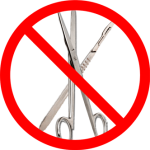Cervical Stenosis and Myelopathy
As we age, the spine may develop degenerative changes in the joints that can create tightening of the spinal canal. Over time this process may lead to pinching the spinal cord and compromise of coordination of the extremities.Cervical stenosis is a slowly progressive condition that pinches the spinal cord in the neck. Cervical myelopathy refers to this compression of the cervical spinal cord as a result of spinal stenosis. Cervical spinal stenosis with myelopathy is more common in elderly patients.A large disc herniation may also result in spinal stenosis.
Signs and symptoms
- Heavy feeling in the legs
- Weakness in the arms
- Deterioration in fine motor skills (such as handwriting or shirt buttoning)
- Neck pain and stiffness
- Pain radiating to the arms and hands
- Inability to walk at a brisk pace
Why it hurts
- As the spinal canal narrows, spinal stenosis pinches the cord and nerves, including nerves that control muscle power and sensation in the arms and legs.Myelopathy affects the nerve tracts that run inside the spinal cord (long tracts) and deficits in these long tracts can be picked up on physical exam.
Non-surgical treatment options
- Neck brace
- Physical therapy
- Pain medications
- Anti-inflammatory medication
- Epidural steroid injections
